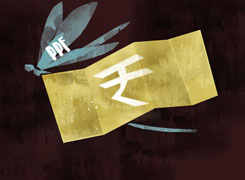Ramalingam Kalirajan |10874 Answers |Ask -Follow
Mutual Funds, Financial Planning Expert - Answered on Jun 03, 2024
He has an MBA in finance from the University of Madras and is a certified financial planner.
He is the director and chief financial planner at Holistic Investment, a Chennai-based firm that offers financial planning and wealth management advice.... more

Hi Rediff guru, my previous provident fund balance is not transfred to new employer . Previous employer needs to file revised ECR. Due to this delay , do I loose interest on the amount lying in previous account?
Transferring your provident fund (PF) balance from your previous employer to your new employer can be challenging. When delays happen, it’s natural to worry about the interest on your PF balance. Let’s explore this situation in detail.
Understanding Provident Fund Interest
The provident fund is a long-term savings scheme. It earns interest annually. This interest is vital for growing your savings over time. Any delay in transferring your PF balance can cause concerns about losing this interest. However, understanding the rules can help alleviate these worries.
Interest Accrual During Transfer Delays
Your PF account continues to earn interest even if there is a delay in transferring the balance to your new employer's account. The balance in your previous PF account will still accrue interest until the transfer process is completed. This is because the PF accounts are designed to benefit the employee, ensuring that their savings grow continuously.
Role of the Previous Employer in ECR Filing
The delay in transferring your PF balance is often due to the previous employer not filing the revised Electronic Challan cum Return (ECR). This ECR filing is essential for updating your PF account status and ensuring the smooth transfer of funds. Prompt action by your previous employer is crucial.
Ensuring Continuous Interest Accrual
Even if the transfer is delayed, the balance in your previous PF account will earn interest. The interest is calculated on the balance available in the account, and this continues until the money is transferred. Thus, you do not lose the interest on the amount lying in the previous account due to a delay in the transfer process.
Importance of Regular Follow-Up
While the interest accrual on your PF balance continues, it's essential to regularly follow up with your previous employer. Ensuring that they file the revised ECR promptly will facilitate the transfer process. Regular communication can expedite the transfer and avoid unnecessary delays.
Assessing the Impact of Transfer Delays
Delays in transferring your PF balance might not impact the interest earnings, but they can cause administrative and financial inconvenience. For instance, if you need to access or withdraw funds, the delay can be problematic. Therefore, while interest is protected, timely transfer is still important.
Steps to Mitigate Transfer Delays
Communication: Stay in regular contact with your previous employer and HR department.
Documentation: Ensure all required documents are submitted and accurate.
Follow-Up: Regularly check the status of your transfer request.
Empathising with the Situation
Understanding the stress and inconvenience caused by delays in PF transfer is important. We acknowledge the worry and anxiety this can cause. The assurance that interest continues to accrue is a silver lining. However, we appreciate the need for a smooth and timely process.
Evaluating Alternatives
If delays persist despite your efforts, consider seeking help from the Employees' Provident Fund Organisation (EPFO). They can provide guidance and support to expedite the process. This step ensures that you are not alone in managing this issue.
Benefits of a Certified Financial Planner
Consulting with a Certified Financial Planner (CFP) can be beneficial. A CFP can offer personalized advice and strategies to manage your PF and other financial assets effectively. They can help navigate through such administrative challenges and ensure your financial interests are protected.
Conclusion
In conclusion, while delays in PF transfer can be frustrating, the good news is that your balance continues to earn interest. Regular follow-up with your previous employer and possibly seeking help from EPFO are practical steps to mitigate delays. Consulting a Certified Financial Planner can provide further assistance and peace of mind.
Best Regards,
K. Ramalingam, MBA, CFP,
Chief Financial Planner,
www.holisticinvestment.in
You may like to see similar questions and answers below
Ramalingam Kalirajan |10874 Answers |Ask -Follow
Mutual Funds, Financial Planning Expert - Answered on Aug 16, 2024
Milind Vadjikar | Answer |Ask -Follow
Insurance, Stocks, MF, PF Expert - Answered on Sep 22, 2024
Ramalingam Kalirajan |10874 Answers |Ask -Follow
Mutual Funds, Financial Planning Expert - Answered on Aug 04, 2025
Mayank Chandel |2569 Answers |Ask -Follow
IIT-JEE, NEET-UG, SAT, CLAT, CA, CS Exam Expert - Answered on Dec 08, 2025
Mayank Chandel |2569 Answers |Ask -Follow
IIT-JEE, NEET-UG, SAT, CLAT, CA, CS Exam Expert - Answered on Dec 08, 2025

Mayank Chandel |2569 Answers |Ask -Follow
IIT-JEE, NEET-UG, SAT, CLAT, CA, CS Exam Expert - Answered on Dec 08, 2025
Mayank Chandel |2569 Answers |Ask -Follow
IIT-JEE, NEET-UG, SAT, CLAT, CA, CS Exam Expert - Answered on Dec 08, 2025
Mayank Chandel |2569 Answers |Ask -Follow
IIT-JEE, NEET-UG, SAT, CLAT, CA, CS Exam Expert - Answered on Dec 08, 2025
Anu Krishna |1746 Answers |Ask -Follow
Relationships Expert, Mind Coach - Answered on Dec 08, 2025
Ramalingam Kalirajan |10874 Answers |Ask -Follow
Mutual Funds, Financial Planning Expert - Answered on Dec 08, 2025
Samraat Jadhav |2499 Answers |Ask -Follow
Stock Market Expert - Answered on Dec 08, 2025
Ramalingam Kalirajan |10874 Answers |Ask -Follow
Mutual Funds, Financial Planning Expert - Answered on Dec 08, 2025
Radheshyam Zanwar |6737 Answers |Ask -Follow
MHT-CET, IIT-JEE, NEET-UG Expert - Answered on Dec 08, 2025























